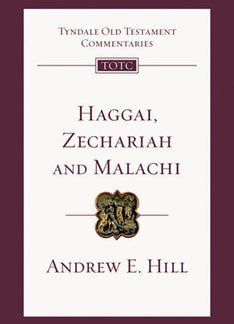Haggai, Zechariah and Malachi — an introduction and commentary
Tyndale OT Commentary
Andrew E. Hill
IVP, 368 pages, £12.99, ISBN: 978-1-84474-584-5
Star Rating : 4
The Tyndale series of commentaries, which first appeared in the mid-1960s, have been a staple in evangelical circles over the last 50 years. They have succeeded in handling the biblical text faithfully, simply and in relation to current interpretative issues.
Time moves on and, while some things remain the same, the issues facing the church change. Also, scholarship moves on and continues to shed further light on a proper understanding of Scripture. For these reasons, a decision to revise the Tyndale commentary series was taken.
Joyce G. Baldwin was responsible for the original commentary on Haggai, Zechariah and Malachi. Andrew E. Hill, Professor of Old Testament at Wheaton College, Illinois, has produced this new edition. He admits to making ‘wide appeal’ to Baldwin’s analysis where appropriate.
The work begins with a general introduction that helpfully sets the three books in historical, canonical and theological contexts. They are written to the post-exilic community and Hill identifies ‘the central theme’ as the second temple: with Haggai focusing on ‘rebuilding’ the temple; Zechariah emphasising ‘repentance’; and Malachi advocating ‘renewal’ of proper temple worship.
All three are fed by the eschatological hope of the coming Messiah, in terms of the restoration of Davidic kingship and its extension over all the earth.
The exposition of each biblical book opens with a similar introduction to the beginning. This leads to repetition when reading through the work as a whole, but does keep the context in view when studying any of the parts.
A structural analysis is then followed by an exposition of the sections or textual units, first in relation to context, then by way of exegetical comment, after which the meaning is addressed to the original hearer.
This method is consistently followed and allows Hill to both interpret the text in a sufficiently academic and practical manner and provide the reader with understanding and application of the passage, in a way superior to the more popular ‘homiletic’-style commentaries.
Overall, this book is a success and would prove a welcome addition to any pastor’s library or as an aid to daily Bible study. On a more critical note, as with many modern commentaries, there is a tendency to give too much credence in places to critical theories of editorial redaction.
Often such theories are based on no more than speculation and Hill is guilty of a number of such speculations. His Christological interpretation is also stronger in some places than others.
With these caveats, however, we welcome this revised Tyndale commentary and look forward to reading others in the series.
Gavin Beers
Ayr




